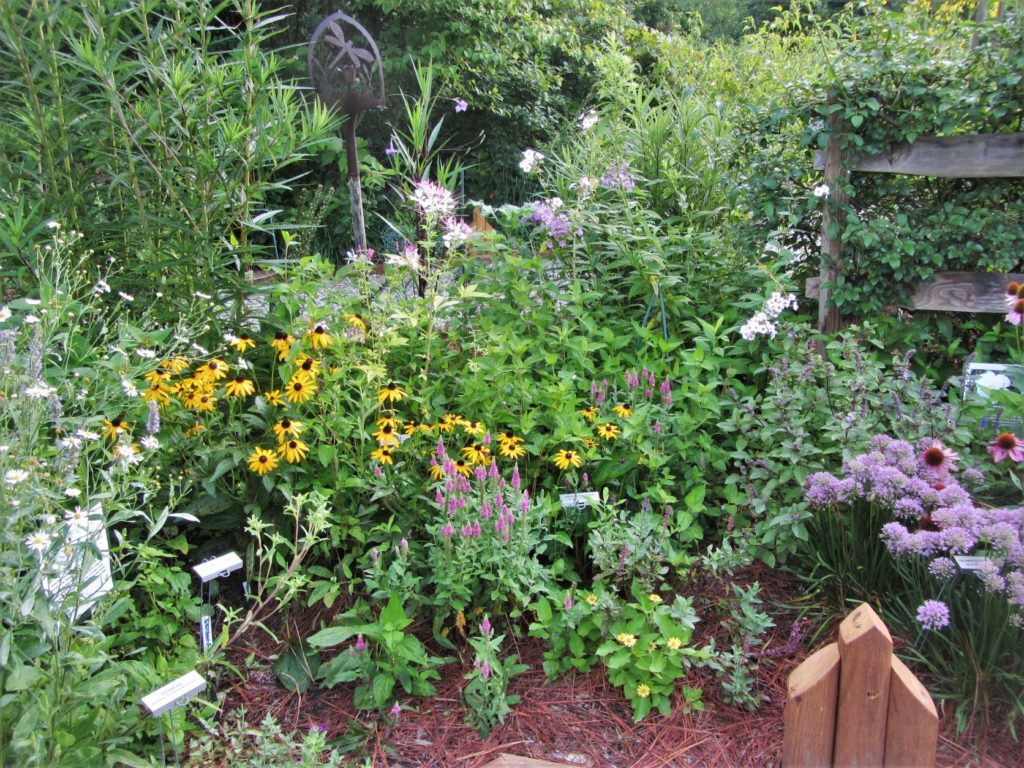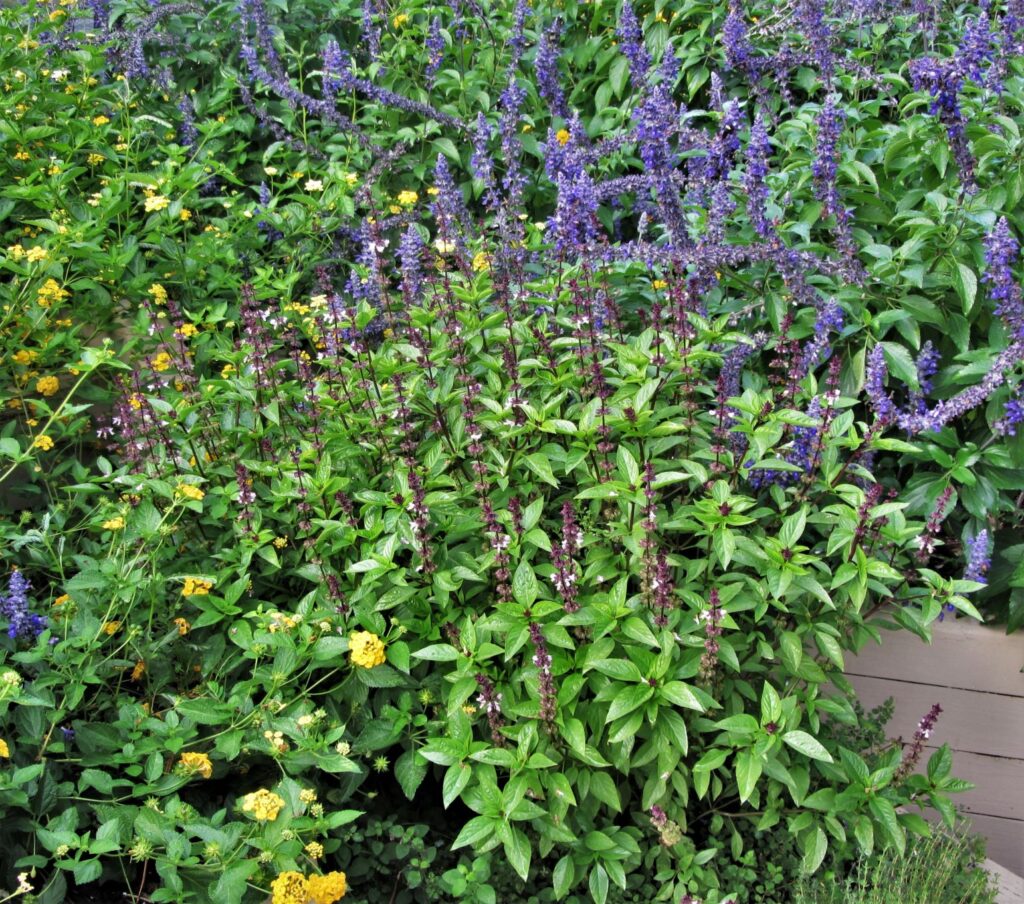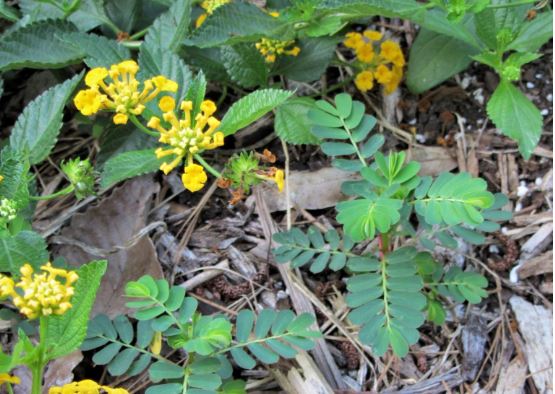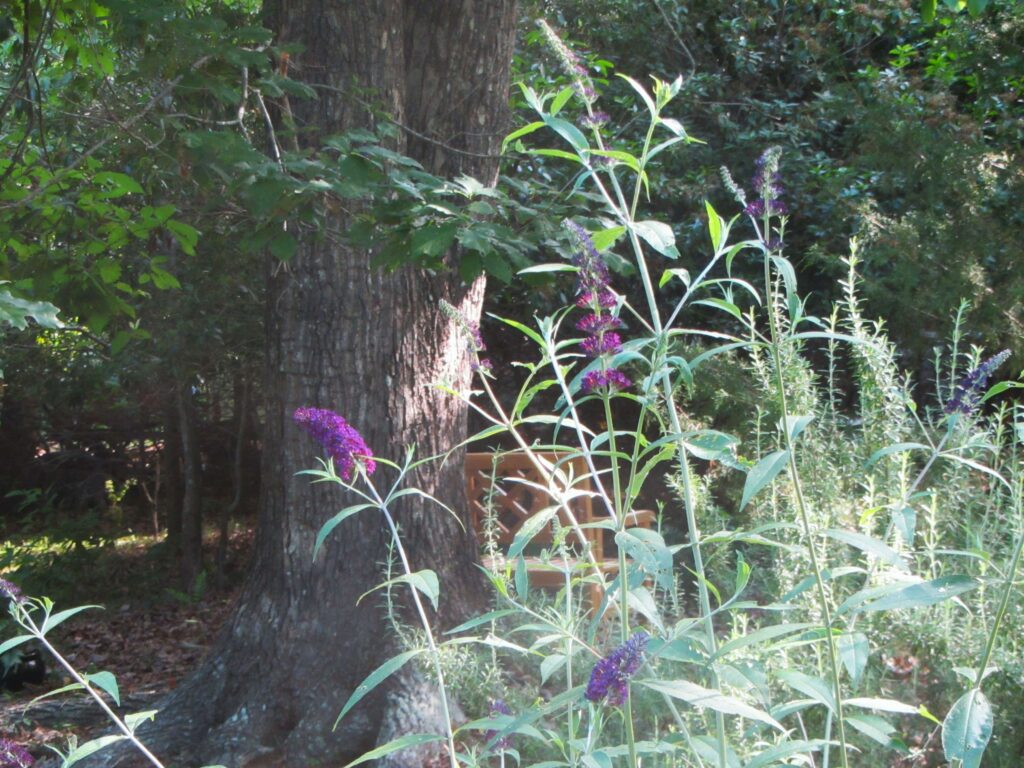Summer in the Garden: To Do, To Do Less, and To Avoid
Summer at last! Tomatoes are ripening, flowers blooming, and we are enjoying prime time in the garden. July and August can be our most productive season in the garden. But these months challenge our ingenuity and dedication when the weather turns hot and dry. All our garden dreams can wither under the summer sun or topple over in a summer storm if we neglect the basic maintenance routines that help our gardens thrive. Here are a few tips to keep your garden beautiful and productive well into the autumn months.
What To Do in July and August
Watering
Summer days can be brutal on plants growing in full sun if their roots haven’t taken hold and grown deeply enough to find water during dry weather. Consider setting up a drip irrigation system for vegetable gardens and soaker hoses in perennial and shrub beds. Delivering moisture at soil level saves water and time.
Clay pots or perforated PVC pipe buried near large plants can be filled with water, allowing the water to slowly seep out into the soil as needed.
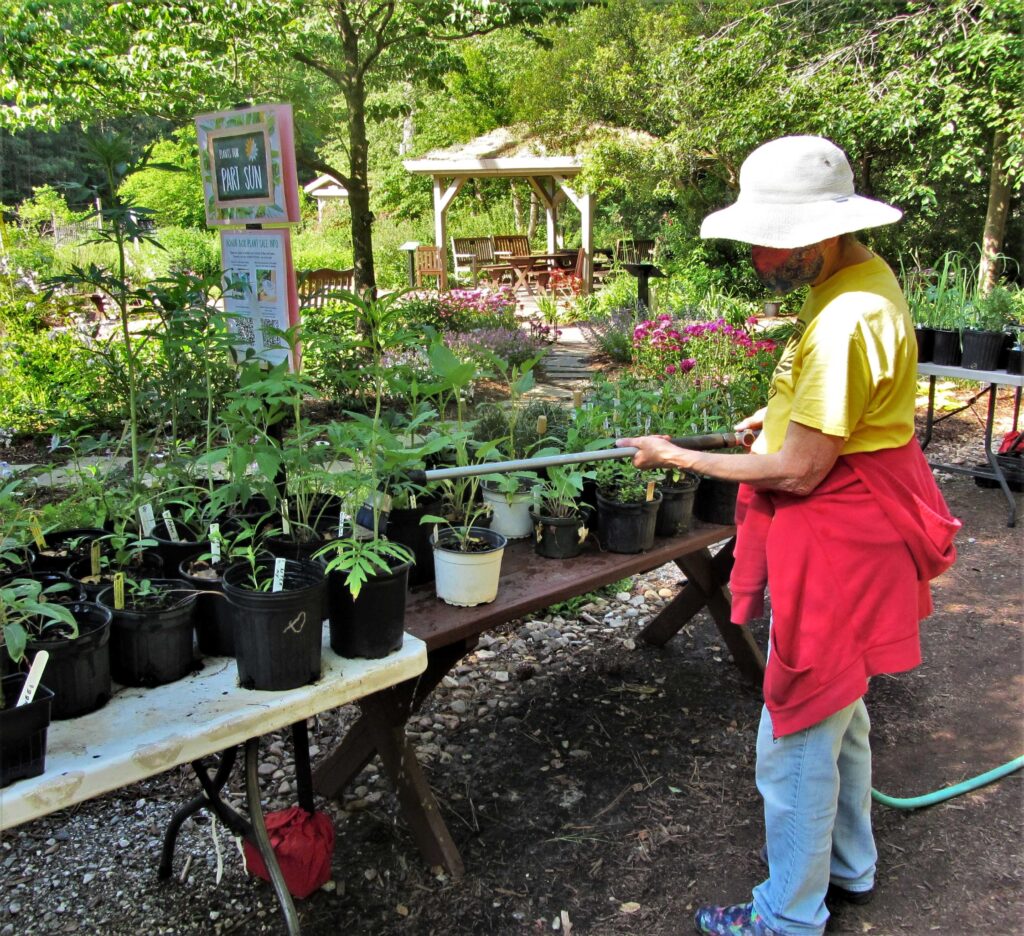
Judith Alberts demonstrates the correct way to water containerized plants at the Williamsburg Botanical Garden and Freedom Park Arboretum in 2021.
If an irrigation system isn’t practical, develop a routine for watering early in the morning, before the heat of the day sets in. It is better for the plants and better for the gardener. When temperatures soar and the soil dries out, it is smart to check plants again in the evening so any that are struggling can be hydrated to allow the plant to heal overnight. Newly planted perennials and most annuals will need regular irrigation until they have grown in. Newly planted trees and shrubs need irrigation through their first year, and during times of drought after that.
Neglecting regular irrigation can ruin our gardening investment as plants fail to thrive or die. Keep in mind that wildlife like rabbits, deer, squirrels, and birds may seek moisture from our garden plants during drought. Consider adding water sources for wildlife to discourage them from eating your new annuals and perennials for their moisture.
How to Save a Struggling Plant
Remaining plants for sale in garden centers may already be root bound and struggling in their tiny nursery pots. Many of these will go on sale and we might wonder whether they are worth taking a chance. Newly purchased transplants which we planted in the garden in recent months may be damaged from intense heat during our recent dry spell. Some may have been damaged by voles eating their roots or grazers eating their leaves and stems. Most of these plants can be saved and will grow on into productive plants.
Three principles to save a stressed plant: hydration, shade, and leaf to root ratio.
Stressed containerized plants should be watered deeply. Potting soil can grow hard and difficult to re-hydrate once it is completely dried out, so set the container(s) into a shallow watertight container and let them soak in an inch or two or water until the plant perks up and the soil is fully moistened. Add a dilute solution of fish and seaweed emulsion, or granulated orchid food to the water to give the plant a boost.
While the plant is soaking, cut it back to remove any spent flowers, damaged stems and leaves, and any lanky growth. Never remove more than half of the plant at once.
Keep the plant in the shade until it perks up. Give it a few days to stabilize and then transplant it into a larger container or into the ground. Gently loosen any circling roots around or under the plant during transplanting to encourage them to grow out into the surrounding soil. Keep the plant watered as it recovers from transplanting.
Plants recently transplanted into the garden in April or May might not have settled in before the hot dry weather of June. If their leaves look limp, have crisped on the edges, or if the plant is clearly struggling, take action to save it by watering deeply, cutting back flowers and any lanky growth, removing any brown or yellow leaves, and possibly providing some temporary shade.
If you suspect that voles have attacked a plant’s roots, then you may want to move it to a better location. Prune the plant so the remaining roots don’t have too much volume to hydrate.
Protect a damaged plant from grazers with repellent sprays or with a temporary wire cage. Add mulch, if needed, after watering. Remember to keep the plant watered as it recovers. Water with a diluted solution of fish emulsion or compost tea to give the plant a boost.
Deadhead, Prune, and Harvest
Deadheading spent flowers and pinching back the growing tips of stems are types of routine pruning that help keep plants bushy and productive during the summer. Cut back to just above the next pair of leaves down the stem, using clean scissors, needle nosed pruners, or even your fingertips to harvest herbs or to ‘pinch-back’ new growth. This sends a hormonal message to the lower nodes, signaling new stems to grow from buds where each leaf emerges from the stem.
Harvesting flowers, berries, herbs, and vegetables regularly during the summer makes the plant grow and bloom more profusely. Harvest and freeze or dry herbs in July and August to use next winter.
Take Leaf and Stem Cuttings
Soft green stem cuttings will root easily in water or damp sand. Take a cutting with 3 or 4 leaf nodes and remove all but the uppermost leaves and the growing tip. Keep cuttings indoors, or in the shade outside, as they root. A cutting rooting in sand or potting soil may need a covering to increase humidity until it grows its first roots. An inflated clear plastic bag, a clear plastic drink cup. or a small greenhouse can all help increase humidity so the remaining leaves don’t wilt. Once a stem has roots, it can be potted up with fresh potting soil in a container deep enough to support it until fall. Use this technique with herbs, shrubs, flowering annuals, and with some perennials to increase your inventory of preferred plants. This method of propagation doesn’t work with ferns, however.
Some leaves, like Coleus, Begonia, African violets, and Caladiums to name a few, will also root in water and eventually grow into new plants.
Control Weeds
Weeds compete with desirable plants for available resources, particularly for water and nitrogen in the soil. Allowed to grow too long, they will also shade out desirable plants.
Pulling weeds up to remove their roots often brings new weed seeds close enough to the surface to germinate. It is better to cut off weeds at ground level and then cover them with mulch. Putting down newsprint or brown paper, covered with mulch, is an effective way to suppress weeds. Many gardeners sow flower or vegetable seeds where weeds have been removed to fill the space and shade out germinating weed seeds.
Stake, Support, and Tie-in
Many plants require support to grow vertically because their weight will make them fall over, especially during heavy rain or strong winds. Vining crops like beans, tomatoes, squash and cucumbers will need to be tied-in to their supports regularly as they grow. Use soft ties that won’t cut into the stems. There are many different types of support available including cages, trellises, pergolas, and simple stakes. Choose or construct supports based on how tall a plant is expected to grow and how much access you may need to harvest vegetables from the plant during the season.
Renew Thinning Mulch
Mulch serves several useful purposes in the summer garden. It helps retain moisture and carbon in the soil, particularly on sunny days when the soil dries out rapidly. It can keep the plants clean during rain showers or watering, and can stop the spread of fungal disease from soil to leaf. Organic mulches slowly fertilize the soil as they decompose. Mulched crops will be more productive and will require less irrigation. Low ground cover ‘living mulch’ plants are also effective in protecting the soil and may be more attractive than bark mulch in ornamental gardens.
Mulches may grow a little thin by mid-summer. Add additional mulch as needed to maintain a 2”-3” layer around trees, shrubs, perennials, and productive vegetable crops. Consider these options: shredded bark, wood chips, compost, coffee grounds, grass clippings, shredded leaves, straw, pea gravel, perma-till, and shredded paper.
Handle Voles and Grazers
Voles and moles eat plants from the bottom up, feasting on root systems and sometimes gnawing the stems of shrubs. Sometimes an entire plant may disappear down a vole hole. Predators like hawks, owls, and even cats may help keep voles in check. Some gardeners add a product called ‘perma-till’ to the back fill and the bottom of planting holes to discourage voles. Backfill or pea gravel can be poured into holes and tunnels to discourage these mouse like burrowing animals. Poisonous plants like daffodils and hellebores planted around a desirable tree or shrub offer some protection. Voles also eat invertebrates in the soil and may tunnel under lawns as well as in planting beds. Crush tunnels as they appear and investigate the various traps and products available to discourage their activity.
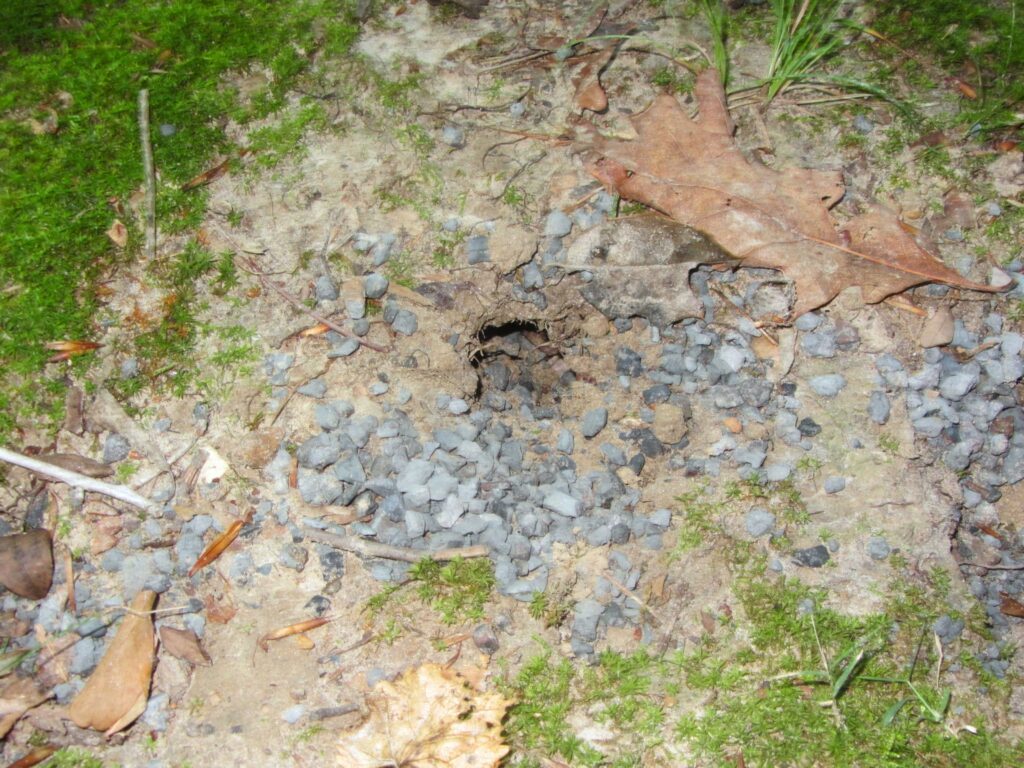
Voles and moles tunnel underground, eating roots and invertebrates. There are many ways to discourage and stop them, none of them will always work.
Grazing animals like deer and rabbits eat a wide variety of plants, often grazing on plants that surprise us. They may consume plants they would generally ignore when they get very thirsty in mid-summer. The more fertilizer in a plant the more they crave it because nitrogen is a salt. Plants we want to eat, like tomatoes and lettuce, are very appealing to deer. Most flowers are actually ‘deer candy’ and are vulnerable to grazing.
Grazing is a crude form of pruning, and more established trees and shrubs can recover after losing a few leaves on lower branches. Seedling trees and flowering ornamental plants may never fully recover after a deer has finished grazing them. Deer or rabbits may pull young plants up completely, leaving their root balls exposed.
There are many granular and spray repellent products that have limited success. Heavy rain will wash away sprays and they need to be reapplied frequently. Fences and wire cages around specific plants may be the only reliably effective ways to keep grazers away from garden plants.
Evaluate and Plan for Next Year
June and July offer another opportunity to evaluate how well plants are performing. Are things sited well? Do the forms and colors work well together? Do we like the varieties we’ve chosen? This is a good time to take photos and make notes.
Prepare for Fall Planting
We have a very long planting season in the Williamsburg area. September through late November is like a second spring, allowing us to grow additional vegetables, herbs, and flowers deep into autumn. Plan for succession planting for short season crops like greens and radishes, and plan to get a head start on crops that can overwinter like carrots, turnips, and collards.
Most ornamental containers will be due for a refresh by early September, too. Decide what you will plant as summer wanes and go ahead and order spring bulbs, seeds, plugs, and any new trees and shrubs.
Start seeds for some fall transplants indoors so they are well-developed and ready to transplant by late August. Fall is the best season to plant in our area to allow time for roots to grow overwinter.
Protect Your Health
Dress for success and safety! Ticks, spiders and insects are out there looking for their next meal, so choose a gardening outfit that protects your skin from bites and sunburn. Remember a hat and gloves for further protection. Use sunscreen on exposed skin during mid-day.
Bring water to sip as you work to prevent dehydration, particularly on hot and humid days. Dehydration and heat exhaustion can happen very suddenly while we are busy working outside. Take breaks in the shade and stay hydrated to beat the heat. Know your own limits, and limit the time you spend outside in the heat of midday.
Stretch, lift carefully, and don’t overdo it. We are all used to the normal aches and pains from hard work, but we should work carefully and avoid injuries whenever possible so we can keep doing the gardening tasks we enjoy.
Enjoying
Take time to enjoy your garden. Just sitting and staring is an important garden task because we see more when we take a moment to just be still. Our appreciation for the web of life our garden holds deepens as we notice the small and quiet animals sharing the space with us. Taking even ten minutes a day for a quiet walk or to sit quietly outside allows us to enjoy the results of our efforts.

Carex ssp. may look like grass, but is a very tough, evergreen perennial sedge which requires little maintenance. Williamsburg Botanical Garden and Freedom Park Arboretum, 2022
To Do Less
Reduce Mowing
Hot dry weather is stressful for our lawns. Mowing the grass too short, or two often, damages the lawn. Set the mower a bit higher in mid-summer and avoid mowing during a drought when grass is growing more slowly.
Reducing lawn area by creating beds for shrubs and perennials, ground covers, and other plantings saves time, energy, and reduces the pollution our garden generates. Going longer between regular mowing has the same benefits and is gentler on the wildlife living in our yards. Consider growing short ornamental grasses and grass-like plants, like Carex, instead of lawn grasses. Cultivate moss or other ground covers in shady areas.
Mowing the lawn is a part of the summer routine, but is a lot of work and takes time to complete. Many families now hire lawn care companies to come in with multiple commercial sized mowers and blowers making a huge racket endured by neighbors for blocks around the work site. Most of that equipment is gas powered, which means the fumes waft down the street to other yards and homes. If we stop to consider the air pollution involved from a single lawn care visit, it is considerable.
Battery powered mowers, blowers, string trimmers, and hedge clippers are much quieter and don’t fill the air with fumes. Doing these tasks ourselves, when possible, is more economical and saves the trip with the big pick-up truck and trailer, hauling all the equipment. We save ourselves and our neighbors from breathing all those fumes and pollutants, too.
Reduce Fertilization
Container plantings require a lot of nutrition to produce abundant blooms. The easiest way to feed containers is with time released granules or pellets, like Osmocote. Spring fertilizer will need renewal in July or early August. It may be that an inch or two of compost is all that is needed to keep shrubs, perennials and vegetable gardens productive. Add a little compost along with fresh mulch as needed if plants begin to look stressed or growth slows. Compost won’t burn the plants.
Take a soil sample and have it analyzed by the Virginia Tech Extension labs to determine what soil amendments are needed before pouring on the fertilizer for lawns and vegetable gardens. Extra fertilizers will wash away into local waterways, potentially clogging them with algae and other growth. Fertilizer remains expensive, so it makes good economic sense to use only what is needed.
Reduce Wasteful Watering
Much of the world is already experiencing water shortages, and the price of municipal water continues to rise. Explore ways to save and use this precious resource more wisely. Consider collecting rainwater in rain barrels or rain gardens. Experiment with different types of mulch to see what works best in your yard. Use soaker hoses or buried reservoirs whenever possible to avoid overhead spraying. Use drought tolerant garden design techniques to reduce water use.
To Avoid
Pesticides
Pesticides include herbicides, insecticides, and fungicides, all designed to kill. All impact more organisms that they were designed to kill, and many impact human health, as well. If we accept that insects are important in the food web of our yard, then insecticides reduce the number of insects available for birds and small animals like frogs, lizards and turtles that depend on them. Insecticides intended for an insect pest may also kills native bees needed for pollination, and already endangered butterflies or dragonflies.
Pesticide residue remains in the soil, and all too often washes into waterways and ground water. We breathe it. It gets onto our skin and affects our own biology in ways that may not be apparent for years to come.
More and more gardeners are making the commitment to stop using herbicides and insecticides and instead foster a sustainable ecosystem within their yard. Allowing insects to thrive attracts those creatures that will eat them. Manually removing unwanted vegetation allows us to improve our soil with home-made compost instead of poisoning the soil, and the life in the soil, with harsh chemicals.
Remove insect pests like Japanese beetles by hand if needed. Use non-chemical traps for pests.
Take the James River Association’s River Hero Pledge to protect the James River from your own yard, and register your yard as a certified wildlife habitat with the National Wildlife Federation to share your commitment to a healthy and sustainable ecosystem.
Dividing, Moving and Planting New Plants
Autumn is the best time to divide perennials, to dig and move established plants, and to introduce new plants to the garden. Pot up late season purchases at nursery sales in a slightly larger container to grow-on in part sun or shade until autumn. Wait until the weather cools and rain becomes more dependable before adding plants to gardens in full or part sun. If you decide to plant out in the garden, provide some shade and keep the new addition well-hydrated as it adjusts.
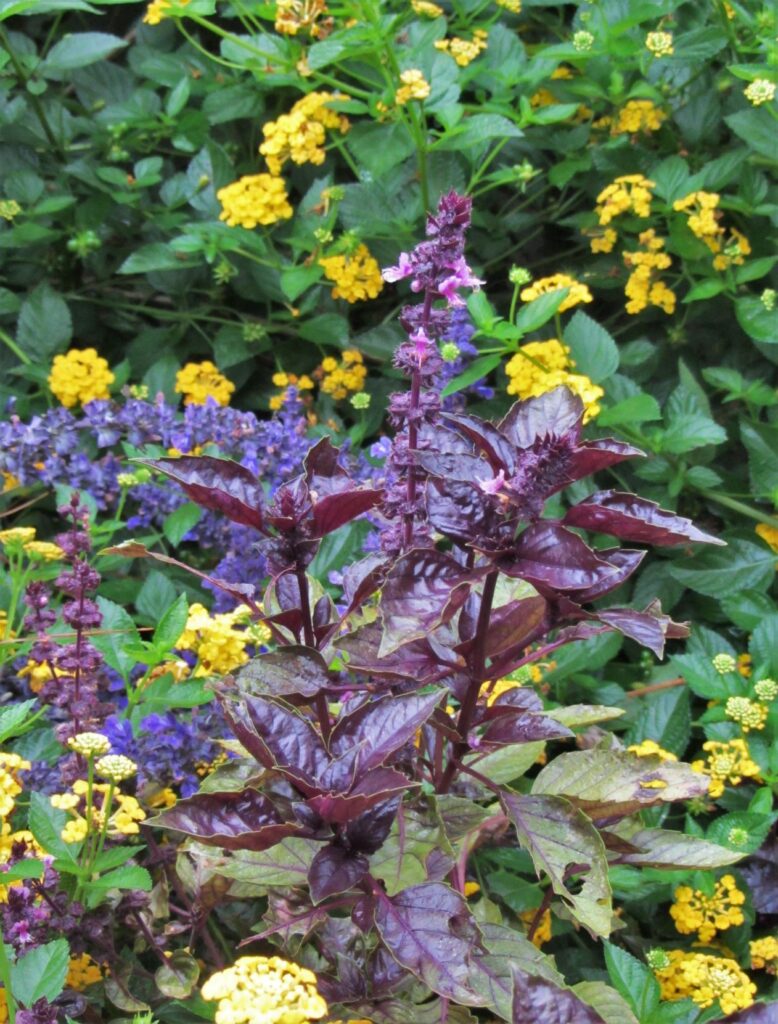
‘Dark Opal’ basil blooms over several months, attracting hummingbirds and other pollinators. It thrives in hot, sunny areas.
Summary
Good gardening is both an art and a science. We are always experimenting and finding better ways to accomplish our goals. Every gardener and every garden have their own opportunities and their own challenges. And what works in one year may not work as well as time goes by. Our gardens change, and so do we.
In this age of climate chaos, we need to contemplate systems rather than tasks. We need to make the most of the resources we have and consider every aspect of our own impact on the ecosystems we care for. A little thought and creativity will show us the opportunities within our challenges. As we work with nature, rather than against the natural processes occurring in our gardens, we participate in the unfolding of a beautiful and balanced ecosystem around our home.
All photos by E. L. McCoy

